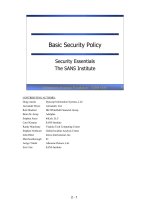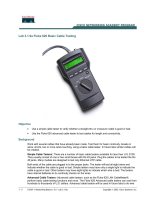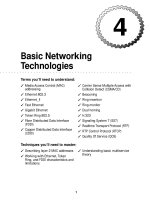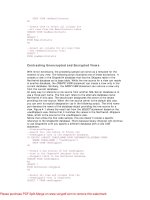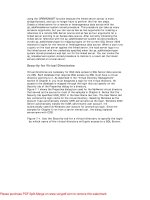Basic Beekeeping Operation doc
Bạn đang xem bản rút gọn của tài liệu. Xem và tải ngay bản đầy đủ của tài liệu tại đây (28.8 KB, 8 trang )
Basic Beekeeping Operations />1 of 8 30/08/2006 9:53 AM
Basic Beekeeping Operations
Hive Location
While bees can fly up to two miles to find nectar and pollen, they do best with less "travel time." Bees can be
kept almost anywhere; they do not have to be in a "perfect" spot. Choosing the best possible location,
however, increases the chances for a strong, productive colony. Consider both the bees and your neighbors
when making your decision. Some points to keep in mind are:
Bees need water to dilute honey and cool the hive during hot weather. If water is nearby, they can
spend more time gathering nectar and less time collecting water. If necessary, a dripping garden hose
or water trough filled with coarse gravel may be placed near the hive. Bees will drown in deep open
water containers.
1.
Bee behavior is affected by temperature. They rarely work when the temperature is below 57
o
F or
above 100
o
F. They cannot fly when the temperature is below 55
o
F. On very hot days, bees cluster
outside unshaded hives and do not work. However, too much shade in the summer makes bees irritable
2.
Windbreaks provide some protection from cold winter winds. Bees eat more stores and are more
susceptible to dysentery when located where cold winds hit the hive.
3.
Field bees orient themselves with the sun and usually fly from mid-morning to mid-afternoon. Avoid
placing hives on the west or north sides of buildings. Orient the hive entrance to the south or southeast
but not into prevailing winds.
4.
If you are in hilly country, locate your hive in a valley. Bees fly uphill for nectar and downhill when
loaded with pollen or nectar. Locate the hive so you can carry filled supers down the slope to your
storage area.
5.
Locate your bees close enough to your home to observe them regularly.6.
Hives near highways, sidewalks, or watering troughs might be a nuisance. If your hive is in this
situation, build a high fence so bees leaving and returning to the hive must fly over the area.
7.
Avoid locating the hive near large rivers bees must cross to forage. Bees within a half mile of wide
rivers often drop into the water and drown when returning home tired and loaded with nectar.
8.
Bees will fly two miles in any direction over level ground for nectar, but honey production increases if
nectar is closer. Try to locate the hive near fall and spring nectar sources.
9.
Examining the Colony
"Going through the bees" is a phrase beekeepers use for opening the hive to examine the condition of the
brood and food stores and look for signs of disease, swarming, or anything else that needs attention. During
off-seasons, especially winter, monthly inspections are generally sufficient. During the six-week period from
the beginning of rapid colony buildup to the beginning of the spring nectar flow, examine the colony weekly.
When opening a hive, take precautions to avoid harm to the bees and yourself. Most danger is avoided by
working slowly and carefully and wearing the appropriate protective gear. The most important item is the bee
veil because stings around the eyes or temples are more dangerous than stings elsewhere. Also, reacting
suddenly to stings around the head entices more bees to sting.
Bees dislike dark, woolly, or sweaty materials, so wear clean, light-colored, cotton coveralls or a
long-sleeved shirt and full-length pants. Tuck your pants cuffs into your socks and your shirt cuffs into your
bee gloves, or tie your pants and shirt cuffs so bees can't get in. Bees have a harder time stinging through
loose clothing, but do not wear clothing that flops about. Many beekeepers are toughened enough to tolerate
a few stings on the hands so they often do not wear gloves, which are slightly cumbersome. However, it is
Basic Beekeeping Operations />2 of 8 30/08/2006 9:53 AM
best to wear gloves until you know how you will react to stings on the hands. Dropping a frame of bees or
swatting at a stinging bee only makes things worse.
Weather and other conditions influence the temper of bees, so examine the hives under the most favorable
conditions. During a nectar flow, bees work from mid-morning to mid-afternoon on calm sunny days when
the temperature is above 70
o
F. Bees are more even-tempered when they are busy. Also, when most of the
field bees are out foraging, fewer are in the hive to interfere with your inspection. Bees tend to be irritable
between nectar flows or on poor flying days. When bees are actively brood rearing, avoid opening the hive
on cold, overcast, or windy days lest the brood be killed by chilling.
Your smoker should be lit and smoldering properly before approaching the hive. Move to the hive from the
side or rear; stay out of the line of flight. Move slowly and avoid making quick or sudden motions. Reach
around to the front of the hive and give the entrance two or three puffs of smoke. This disorganizes the guard
bees and distracts the others from what you do next. Quietly remove the top cover and place it upside down
on the ground to the rear of the hive. Puff some smoke through the hole in the inner cover, wait a few
moments, then pry up the inner cover with your hive tool. Puff a little more smoke under the cover as you lift
it off. Lean the cover against the hive. Use additional smoke if necessary, but do not overdo it. A little smoke
stimulates the bees to fill up on honey and be peaceful; too much smoke drives them from the hive and
disrupts their workday.
Bees glue contact points together with propolis, so frames must be pried loose with the hive tool. Insert the
tool between the hive wall and the ends of the frames to pry them loose. Then pry between the outside frame
and the one next to it to separate them from each other. Remove the outside frame, which usually contains no
brood, and stand it on end against the shady side of the hive. There is now space in the hive to shift the
remaining frames. They can be removed, examined individually, and replaced. Do not set any of these frames
down outside the hive. Examine as few frames as possible to assess the condition of the colony. Keep the
hive open only as long as necessary to judge its condition.
Avoid crushing bees when shifting or replacing frames, especially the queen. Crushed bees emit an odor
which excites other bees to sting. After a nectar flow, do not keep a hive open for more than a few minutes at
a time. Otherwise, bees from other colonies might begin robbing. Robbing results in heavy bee loss. If it
starts, put the hive back together immediately and place some grass in the entrance to help the bees repel
robbers.
When looking at the frames, hold them vertically by the ends of the top bar. Stand so that the light comes
over your shoulder. To see the opposite side of the frame, raise your right hand until it is above your left hand
and rotate the frame like a hinged door until the opposite side is in full view
. Then bring your right hand
down level with your left. The frame will be upside down in your hands
. Depending on the season, things to
look for are:
Is there sufficient honey and pollen?1.
Is the queen healthy? If eggs and brood are present, the queen is probably all right.2.
Are swarm cells present? If so, destroy them and check further for conditions that might cause swarm
reparation.
3.
Is there enough room for the queen to lay and for the workers to put away stores?4.
Are the combs broken or sagging or with many drone cells?5.
Is the brood diseased? Are there sufficient worker bees? Too many drones might be a sign of a failing
queen or poor combs.
6.
Record your observations in a notebook immediately after hive examination. Look back at this
information to review the season's activities and plan for next year.
Basic Beekeeping Operations />3 of 8 30/08/2006 9:53 AM
Bee Stings
All honeybee workers are potential stinging insects but usually sting only to defend their colony or
themselves. To avoid stings, do not pass directly in front of a colony of bees. Instead, work from the
side or back. If a flying honeybee comes near you, remain still or walk to a brushy area, building, or
vehicle. Swatting at bees aggravates them
If you are stung, remove the stinger immediately by scraping it with your fingernail or a knife. Do not
squeeze the stinger. This injects the full dose of venom into your skin. The scent of the poison often
alarms and irritates additional bees, so either wash the wound site with a natural odor or apply a few
puffs of smoke to mask the scent. Rubbing the wound only produces more itching and swelling.
Persons made ill by one or several stings ordinarily should not attempt to work with honeybees.
Evidence of oversensitivity to bee stings includes a sharp change in the pulse rate, difficulty in
respiration, loss of consciousness, and hives on various parts of the body.
Requeening
Many queens live five years and some up to nine years, but vitality decreases with age. The aging
process is hastened by a high demand to lay eggs. Most beekeepers prefer to replace the queen before
she begins to fail. This can be a yearly process, but in our area most requeen every other year.
Requeening is relatively inexpensive, especially when you consider the production loss and generally
weakened colony due to a failing queen.
A queen may begin to fail at any time so always check her condition. Several symptoms can alert you
to the problem. An old queen usually has a dark dull appearance because her body hairs have been
broken or rubbed off. The edges of her wings might be worn and ragged and her abdomen might droop
away from her thorax. She moves more slowly and might avoid the workers. Also, very old queens lay
mostly drone eggs. The brood area of a failing queen is smaller than normal or "scattered" on the
comb. Honey production is down even when production conditions are favorable. The workers build
supersedure cells near the center of the comb in preparation for replacing a failing or missing queen. At
this point, it might be just as well to let the queen be superseded rather than purchase a new queen.
However, it is best not to let the situation deteriorate to this point. If the queen is missing for an
extended period of time, workers might begin to lay unfertilized eggs. These eggs only produce drones.
Unlike the queen, laying workers deposit several eggs in each cell. It is often difficult to requeen a
colony that has been queenless for some time.
Requeening can be done at several times. Select a period when nectar is coming into the hive. This
improves the chance of the new queen being accepted. The earliest time in the year is in spring when
bees are bringing in nectar about six to eight weeks before the main nectar flow. The advantages then
are few supers to handle and a relatively small colony. Also, the old queen is easier to locate, and it's
easier to check for acceptance of the new queen. A disadvantage is the higher cost of queens during
this time.
Some beekeepers requeen after the main nectar flow begins. If the old queen has been laying fairly
well, she will have laid most of the eggs needed for a good work force. The disruption of brood rearing
by introducing a new queen is only slight. A disadvantage is difficulty working through the large
number of bees to locate the old queen.
Requeening can be done in the fall if there is a dependable nectar flow. The colony is not overly large
at this time, and a good queen will be established for the spring buildup.
Basic Beekeeping Operations />4 of 8 30/08/2006 9:53 AM
The simplest requeening method is to introduce a purchased queen from the mailing cage. About
midday, as soon as possible after the queen arrives, open the hive using as little smoke as possible.
Remove the brood chamber combs one by one, checking each one carefully for the old queen. When
you locate her, kill her and destroy any queen cells present. Uncover the candy hole in the end of the
mailing cage and punch a small nail hole through the candy. Suspend the cage in a horizontal position
between the top bars of two center frames of the brood chamber. Close the hive, and do not disturb it
for seven days. At the end of this time check to see if the new queen has been accepted. Look first at
the mailing cage to see if she is free. If she is not, enlarge the candy hole or release her directly into the
hive. If the queen is free and eggs are present in brood cells, it is not necessary to locate her.
Swarming and Its Control
A beekeeper can use one of several artificial methods to increase the number of colonies, but the
natural method by which bees increase colonies is swarming. Swarming reduces honey production for
the season because the parent colony and the swarm each have fewer bees than the original colony.
They do not build to full strength as quickly as the original colony would have if swarming had not
occurred.
When preparing to swarm, bees build large numbers of queen cells along the bottom of the comb.
Shortly before a new queen emerges, the bees stop their field work. The swarm bees, usually at least
half the bees in the colony, engorge with honey. They leave with the queen, fly a short distance, and
cluster on a bush or tree limb. They wait there while scout bees locate a satisfactory hiving place.
During the wait, the bees are very gentle and can be handled with much less danger of stinging. If
scout bees come back with news of several satisfactory hive sites, the swarm somehow selects one. The
dense ball of bees breaks up into a boiling cloud and flies directly to the new hive.
After the first swarm leaves the old hive, new queens may lead other swarms from the hive within a
few days of each other. After all the swarming is over, normally enough bees are left in the old hive to
keep it going although the colony strength might be greatly weakened.
The impulse to swarm is governed partly by the innate character of a bee colony and partly by
conditions in the hive. Some races of bees tend to swarm more than others. However, swarming is most
often associated with overcrowding in the hive. Overcrowding can result from a variety of
unsatisfactory hive conditions (Table 1
) including lack of supers, improper super sequence, poor comb
spacing, poor ventilation, too many young bees or drones, and combs filled with honey.
A common time for overcrowding is when pollen becomes abundant in spring and prompts a rapid
increase in brood rearing. Brood cells are filled with brood faster than they are emptied by the
emergence of new bees, so the area containing brood expands. The area being filled with nectar and
pollen also increases. If space is not provided to accommodate this expansion, swarming is apt to
occur.
During the spring buildup, inspect the colony weekly to see that ample space is provided for brood
rearing and honey storage. Brood chambers need to be added if the colony overwintered with one hive
body. If the colony has more than one brood chamber, chambers should be rearranged to best
accommodate the expanding brood. Normal colony behavior is to expand the brood nest upward, so put
brood chambers that are empty or contain the oldest brood on top and the chamber with the youngest
brood on the bottom. Brood chambers might need to be rearranged every two to three weeks until the
nectar flow starts. After the nectar flow starts honey supers should be added. See the section on
supering.
Check for signs of swarming during hive inspections and at other times. If a strong colony has few bees
Basic Beekeeping Operations />5 of 8 30/08/2006 9:53 AM
out working on calm sunny days, the colony might be preparing to swarm. If swarm cells are along the
bottoms of frames, swarming will occur soon unless changes are made. Remove the swarm cells and
correct the conditions stimulating swarming. If only a few queen cells are found on the face of the
comb, do not remove them; these are supersedure cells and indicate a missing or failing queen. The
usual time for supersedure is also just before a nectar flow so swarming and supersedure can occur
together. Supersedure swarms contain one or more virgin queens. The former queen is left behind to be
replaced by a queen still developing.
You can prevent supersedure swarming by maintaining a vigorous queen in the colony. This is usually
assured by requeening the colony every other year. An old, frail queen is not able to uphold her
egg-laying task during the demand for rapid buildup of brood just before the main nectar flow.
Workers become eager to replace her with a more efficient queen and begin building a few supersedure
cells on the face of the comb. If you discover supersedure cells during hive inspection, allow them to
develop. It is better to allow the bees to replace the queen than to force them to stay with a queen that
is not productive. Most likely they will keep building supersedure cells until they succeed in replacing
the failing queen.
Supering and Removing Supers
The procedure for supering to obtain the best honey crop depends on the style of honey desired. Styles,
listed by ease of production management, are chunk comb honey, extracted honey, and section comb
honey. Chunk comb honey production is advisable for beginning beekeepers. Supering instructions for
the other styles of honey and special techniques can be found in such books as How to Keep Bees and
Sell Honey, The Hive and the Honeybee, or ABC and XYZ of Bee Culture.
Add a super when the nectar flow starts in your area and the bees begin to whiten the tops of the
frames with new wax. Super frames should be complete with foundation so the bees can start drawing
out the combs immediately. Add a second super to the top when the first is two-thirds full. Add new
supers on top of supers already on the hive. Add the third super when the first is nearly full and the
second is half full. Reverse the order of the first and second supers and add the third on top. If the third
super is being drawn rapidly, put it next to the brood. Reversing supers keeps the bees working
throughout the stack. If more supers are needed, follow the rotation suggested. Do not add supers too
fast or add too many at one time. Remove each super as soon as it is completely capped. Add supers
sparingly toward the close of nectar flow so there are fewer partially filled supers when the bees quit
working.
When a super is completely capped over, move it to the top of the stack and place it on top of an inner
cover that has a bee escape in the center hole. It takes about a day to clear the super of bees with this
method. The next day the super can be removed from the hive. During the day in hot weather, do not
leave on a super containing no bees. Without bees, the combs might melt.
When opening hives and removing supers, be aware of the potential of bees to initiate robbing. To
avoid robbing, do not keep hives open for extended periods of time. Always keep supers of honey
covered, and do not expose combs, especially those not covered with bees.
Feeding Bees
Early spring and late fall are the most important times to watch for the need to feed. Bees are nearing
starvation when no capped honey is in the hives. Bees should have 50 to 60 pounds of stores going into
winter. If properly wintered, enough should be left to build the colony to full strength in time for the
main nectar flow.
Basic Beekeeping Operations />6 of 8 30/08/2006 9:53 AM
The honey crop will be small if bees are still building colony strength during the main nectar flow.
This is due to the small workforce and the fact that they must spend most of their time gathering food
just to maintain the brood. It takes one cell of honey and one of pollen to rear one bee, and the adults
must eat too. Food should be provided if there is an imbalance between brood needs and available
food.
There might be a tendency to overfeed bees too early in the spring or too late in the winter in an
attempt to prepare them for nectar flow. Bees store syrup as if it were honey and may be stimulated to
swarm even if there is not a natural source of nectar. To avoid this, feed bees only the amount they
need when they need it. You will learn by experience to judge the condition of stores by hefting the
hive. Assume a full deep frame weighs six pounds and full shallow frame weighs three pounds. Never
allow stores to drop below 12 to 18 pounds.
The best bee food is ripe honey. Beekeepers often set aside dark, strong flavored, or other low-value
honey to feed bees during emergencies. The honey is left in the frames and used to replace empty
frames as needed. If you do not have honey reserves, make a syrup from equal volumes of pure cane
sugar and water. Bring the water to a boil and remove from the heat. Stir in the sugar until it dissolves.
You can spread dry sugar on the inner cover during warm weather when the bees are flying freely.
Make sure water is available when feeding dry sugar. Sugar candy can be used for emergency winter
feeding and is made as follows. Add 12 pounds of sugar to a quart of boiling water. Stir well and let
simmer for 15 minutes. Add a little salt and a teaspoon of cream of tartar. Let it partially cool, then stir
vigorously and pour into dishes. After the candy is set, a dish may be put upside down over the frames
holding the cluster.
Honey gathered in late fall might not be ripe and can cause problems for the bees. Wintering bees
become loaded with indigestible material from this honey when they cannot get out of the hive to void
themselves in flight. They become restless and die in the hive. Feeding 10 pounds of syrup to the
colony before brood rearing stops in the fall can help.
No special equipment is needed to feed dry sugar, but put syrup in containers large enough to hold a
good amount but not enough for the bees to drown. There are many types of syrup feeders. Some are
designed to be placed in the hive; others are for use outside. Outside feeders might be inaccessible to
bees during bad weather and can encourage robbing by attracting bees from other hives.
One of the best feeders is a five- or 10-pound friction top pail with about a dozen small nail holes
punched near the center of the lid. A large screw top jar may be used as well. Place the feeder lid-down
over the hole in the inner cover on the hive body. Place a super around the feeder and cover with the
top lid.
Some beekeepers prefer to use a division board feeder. The size and shape of a deep frame, it is
supported in the hive by top projections like a regular frame. The feeder sides are made of metal,
plywood, or a similar material. It can be made watertight by coating the inside with melted paraffin.
The top floats on the surface of the syrup allowing the bees to enter and feed without drowning. The
feeder is hung at one side in the hive and may be left there permanently. If no feeder is available, fill an
empty comb with syrup and hang it in the hive.
An adequate supply of pollen is essential for early spring brood rearing. At this time, natural pollen is
scarce and poor weather can prevent pollen collection. This is the critical period for colony buildup so
you might need to feed a pollen substitute. Make this by mixing one part brewer's yeast, two parts
expeller-processed soybean flour, and three parts sugar syrup. Mix these to a paste-like consistency
and shape into cakes to be placed over the brood area of the colony. Start with a small cake in late
Basic Beekeeping Operations />7 of 8 30/08/2006 9:53 AM
winter, and use larger portions as the brood area increases. Continue to feed freshly prepared pollen
substitute until natural pollen becomes available. A pollen substitute may be purchased from supply
dealers and is usually better than a homemade mixture.
Types of Honey Production and Packaging
Honey is classified according to its nectar source or the style in which it is sold. You might not have
much control over the nectar source, which determines the honey's color and flavor. The three main
styles, however, are determined by bee management practices and simply require some advanced
planning. These styles are cut comb honey, extracted honey, and section honeycomb.
Cut comb honey is the easiest to produce and the cheapest to package and market. Simply cut chunks
of honey-filled comb from the frames. Wrap individual pieces in plastic wrap and they are ready for
gifts or sale. The price is not as good as for other styles, but there is usually a ready market. This style
is recommended for the beginning beekeeper.
Extracted honey is the liquid after it has been removed from the comb. Professional extracting
equipment is available but expensive. Small-scale beekeepers can do the job cheaply by crushing the
combs and letting the honey run slowly through strainers. One method is to lay the comb on top of two
or four thicknesses of cheesecloth on hardware cloth or hail screen. This is placed over a dish pan or
collecting dish. The hail screen supports the mass, and the cheesecloth does the straining. Do this when
temperatures are near 90
o
F so the honey will flow. Specialty products such as honey butter and
whipped honey are made from extracted honey.
Section comb honey is the most difficult. It is produced in special square basswood containers. There
are four comb sections in a shallow frame. The bees draw out the comb and fill in the cells in these
sections. In effect, they package the honey for you. The management technique for this style of honey
encourages the bees to swarm and they usually do. A round section adapted for use in standard frames
of foundation is now available and has some advantages over the conventional section comb
equipment.
Moving Bees
Moving colonies is primarily the concern of migratory beekeepers, but you might need to move yours
at some time. Relocating the hive can really upset the colony. Field bees from colonies moved
distances less than a mile tend to return to the original location. Move hives far enough to put them into
unfamiliar territory. While there is no exact minimum distance, two miles is usually sufficient.
The best time to move bees is about dusk, when most of the bees have returned to the hive. Any time
on a cool rainy day is also a good time to move bees provided they are not flying.
Fasten together hive parts using hive staples, lath, steel, or plastic strapping a day or more in advance.
In hot weather, use moving screens in place of regular hive covers. Moving screens are similar to inner
covers that have had the thin-plywood center replaced with eight-mesh hardware cloth. Screen the
entrance closed with a folded piece of window screen or eight-mesh hardware cloth.
When you are ready to load the hives, put on a veil and light a smoker. Smoke the hive entrance well
and wait a minute or two before slipping in the entrance screen. Place the hives on the truck or trailer.
Arrange them as close together as possible and/or tie them in place to reduce shifting en route. At the
new location, put all the hives in place, smoke the entrances well, and remove the entrance screens
immediately.
Basic Beekeeping Operations />8 of 8 30/08/2006 9:53 AM
Uniting Colonies
Weak colonies produce little honey and are poor risks for winter. It is better to take your losses in fall
rather than spring. Combine weak colonies with moderately strong colonies with good queens. Uniting
two weak colonies does not produce one strong colony. Always examine the colonies for signs of
disease before combining them. Kill any queen present in the weak colony. Then place the hive, with
the bottom board removed, above a single sheet of newspaper over the top of the stronger colony.
Punch a few small slits in the paper to make it easier for the bees to remove the paper. The bees should
remove the paper with little fighting as the colonies are united.

